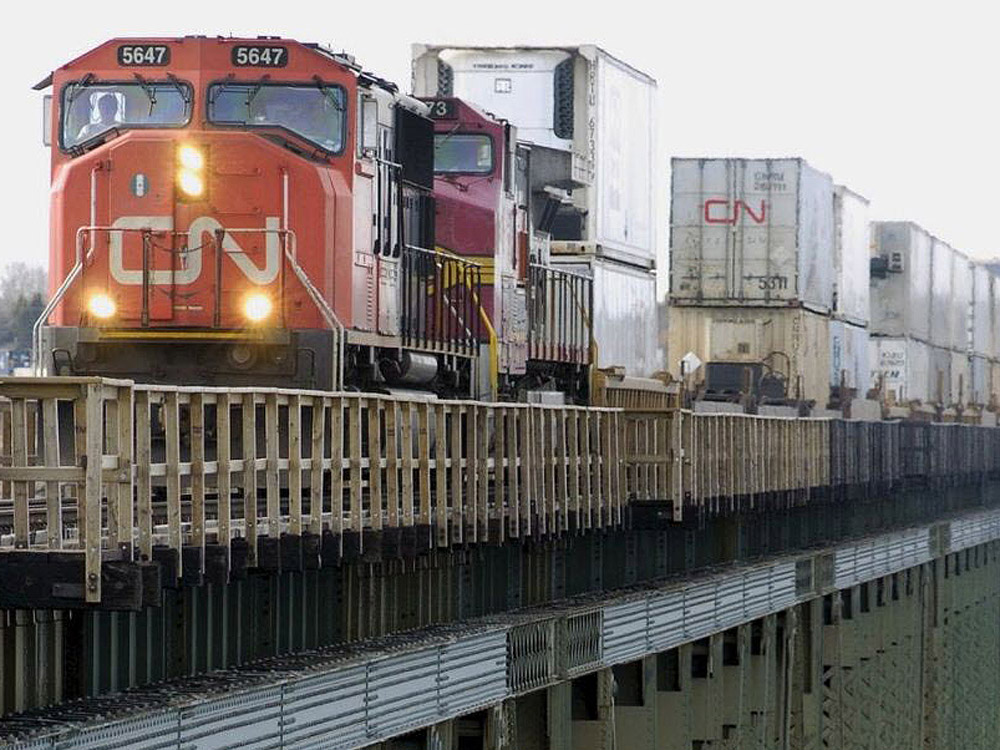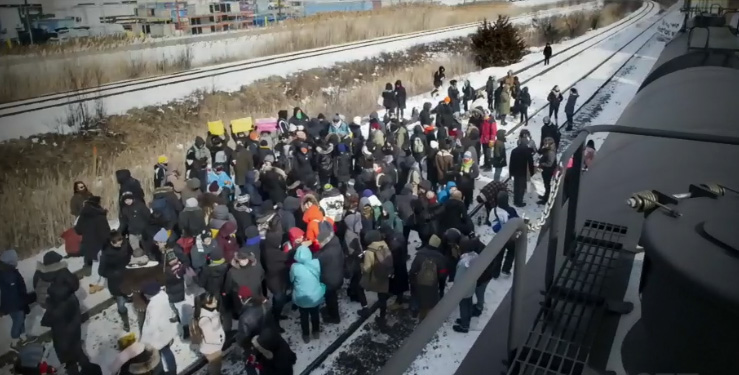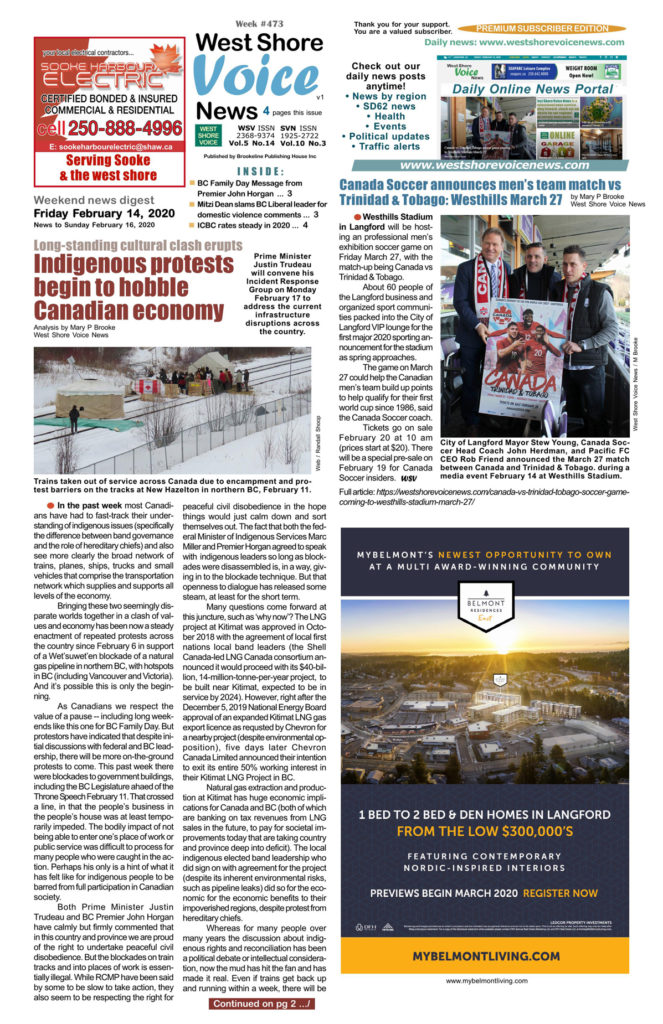
Monday February 17, 2020 ~ NATIONAL
ANALYSIS. By Mary P Brooke ~ West Shore Voice News
In the past week most Canadians have had to fast-track their understanding of indigenous issues (specifically the difference between band governance and the role of hereditary chiefs) and also see more clearly the broad network of trains, planes, ships, trucks and small vehicles that comprise the transportation network which supplies and supports all levels of the economy.
Bringing these two seemingly disparate worlds together in a clash of values and economy has been now a steady enactment of repeated protests across the country since February 6 in support of a Wet’suwet’en blockade of a natural gas pipeline in northern BC, with hot spots in BC (including Vancouver and Victoria).
And it’s possible this is only the beginning.

As Canadians we respect the value of a pause — including long weekends like this one for BC Family Day. But protestors have indicated that despite initial discussions with federal and BC leadership, there will be more on-the-ground protests to come. This past week there were blockades to government buildings, including the BC Legislature ahead of the Throne Speech February 11. That crossed a line, in that the people’s business in the people’s house was at least temporarily impeded. The bodily impact of not being able to enter one’s place of work or public service was difficult to process for many people who were caught in the action. Perhaps his only is a hint of what it has felt like for indigenous people to be barred from full participation in Canadian society.

Both Prime Minister Justin Trudeau and BC Premier John Horgan have calmly but firmly commented that in this country and province we are proud of the right to undertake peaceful civil disobedience. But the blockades on train tracks and into places of work is essentially illegal. While RCMP have been said by some to be slow to take action, they also seem to be respecting the right for peaceful civil disobedience in the hope things would just calm down and sort themselves out. The fact that both the federal Minister of Indigenous Services Marc Miller and Premier Horgan agreed to speak with indigenous leaders so long as blockades were disassembled is, in a way, giving in to the blockade technique. But that openness to dialogue has released some steam, at least for the short term.
Many questions come forward at this juncture, such as ‘why now’? The LNG project at Kitimat was approved in October 2018 with the agreement of local first nations local band leaders (the Shell Canada-led LNG Canada consortium announced it would proceed with its $40-billion, 14-million-tonne-per-year project, to be built near Kitimat, expected to be in service by 2024). However, right after the December 5, 2019 National Energy Board approval of an expanded Kitimat LNG gas export licence as requested by Chevron for a nearby project (despite environmental opposition), five days later Chevron Canada Limited announced their intention to exit its entire 50% working interest in their Kitimat LNG Project in BC.
Natural gas extraction and production at Kitimat has huge economic implications for Canada and BC (both of which are banking on tax revenues from LNG sales in the future, to pay for societal improvements today that are taking country and province deep into deficit). The local indigenous elected band leadership who signed on with agreement for the project (despite its inherent environmental risks, such as pipeline leaks) did so for the economic benefits to their impoverished regions, despite protest from hereditary chiefs.

Whereas for many people over many years the discussion about indigenous rights and reconciliation has been a political debate or intellectual consideration, now the mud has hit the fan and has made it real. Even if trains get back up and running within a week, there will be impacts to some areas of the food supply chain and delivery of products we don’t always think about (like chemicals used to chill indoor ice rinks that make possible the professional and amateur sporting communities and economies they support, for water sanitation, and propane used in some parts of the country to heat homes).
This entire happening has unleashed First Nations pent-up frustration after 150 years of colonialism. It looks like that wound will now bleed raw — the civilized pace of reconciliation that has suited the stability of mainstream Canadian culture is now significantly disrupted. Likely the permission to be enraged that has been made possible through the force and participation of the various protests in both rural and urban areas will grow, in a similar fashion to how the #MeToo movement ‘authorized’ women to finally speak about a sexually abusive corporate culture that has pervaded women in their careers for decades. Case in point, this weekend on CTV’s Question Period: Assembly of First Nations National Chief Perry Bellegarde seemed to almost lose sight of the pipeline protest aspect and went right to essentially (paraphrasing): ‘all indigenous troubles for over 150 years need to be sorted out now’.
This week Canada has witnessed a ‘bloodless coup’. Leadership by Trudeau (first rather skillfully by Miller) and Horgan to fast-track into dialogue and discussion has been appropriate and will likely stave off more immediate interruptions to daily business in communities. But any thought of moderate, boardroom style steady progress to reconciliation is probably not realistic.
Injunctions have been necessary by railways, businesses and government to ensure access to places of operation. In at least one case back east the injunction paperwork was burned on the spot by protestors.
The heat is on for full participation by all areas of society to now focus on normalization for indigenous peoples. Like any person or group that has been sidelined for far too long, the road to inclusion or shared agreement will be bumpy and will take time. One never really knows the day a dam will burst, but now this one has. Managing the torrent of feelings and demands toward achievable solutions is now the work of conscientious and responsible leaders in all camps.
In observing the TV news coverage of the many protests across the country, the support base is largely X-Gen and Z-Gen –including many young women both indigenous and not. That generation’s frustration over incomplete inclusion in today’s economy (forced into ‘gig economy’, the enormous costs of post-secondary, housing, and child care) has mounted, and organizers of recent protests have been clever to tap into that group whose rights and opportunities have been badly squeezed if not trampled upon.

Watching the media coverage of Minister Miller and Premier Horgan it’s clear they grasp the complexity of the issues. It’s mainstream Canada that needs to catch up as to how systematic the exclusion of indigenous peoples has been over many decades. It’s also going to be a steep learning curve for non-indigenous Canadians to really grasp what indigenous leaders mean when they talk about the sacred aspects of land and heritage. Most people regardless of heritage have some sort of spiritual belief system and hold certain things sacred. It does seem like entitlement for indigenous leaders to somehow claim their way is better or of a higher standard; there was even a flavour of that in the resistance of former Justice Minister Jody Wilson-Raybould (rightly proud of her indigenous heritage) to merge into the Canadian mainstream. Her own culturally-based belief system hit a brick wall in the mainstream Ottawa political system, and look at the havoc that caused… leading in part to Trudeau’s bumpy ride to re-election in 2019.
The forces behind the indigenous uprising coupled with and supported by young adults who have been economically sidelined produce a huge tidal wave for social change. The communication skill and social insight by all leaders in this scenario that has quickly become monstrous in proportion to other current issues are what we are relying upon to maintain social and economic stability in these initial heated weeks. This is now likely leading into the months and years that it will take to homogenize the Canadian culture and its governance structures in a way that finally embraces indigenous needs into the mainstream.
No one is dismissing any value of indigenous ways, beliefs or cultural ways, but the modern economy that can bring most people a reasonable standard of living and range of life opportunities is well in place and it makes no sense to damage it. Improvements yes, but not dismantling. How does any disenfranchised group in society find its way into the fold? Step by step, through open doors. Distinct cultures can exist side by side (we see a wide range of cultural diversity in Canada, with newcomers from many parts of the world); cultures are maintained and respected and celebrated. But for overall societal success it is necessary for everyone to have participation in the economy and in the systems of governance. Celebrating distinctiveness while still being operational within the mainstream is the way for everyone to move forward.
Within the indigenous communities themselves is the debate about elected leadership versus hereditary chiefs (which may not exactly be from a descended line but are chosen through ceremony by their community). While that seemed to have sparked this current flame, ironically that will probably sort out separately on the side (a sort of ‘separation of church and state’ within the indigenous governance structure) as Canada deals with the bigger reality of its entire identity under siege.

Standing up to longstanding oppression of one group in society by another is never easy, and can be violent. Back this weekend from a week-long trip to Africa and Europe, Trudeau will be convening his Incident Response Group on Monday February 17 (forgoing his planned government trip to the Caribbean).
From a human rights perspective, this upsurge in support of indigenous rights (or more specifically finally a palpable recognition of their plight as a disenfranchised sector of society) is inevitable. In that respect this building turmoil comes with a sense of relief that issues will finally be addressed.
But the work to sort out this long-developing crisis that seems to now be coming to a head could — in the long haul — take decades. The presumed goal will be to achieve balance between honouring the ways of a people who protected the land for thousands of years and their desire to benefit by the economies of the modern world, without in the meantime damaging the Canadian economy upon which everyone depends.
===== LINKS:
Premier Horgan’s home blockaded by protesters on BC Budget Day February 18, 2020.

======= NOTES:
This analysis piece was first published on pages 1 and 2 in the February 14 to 16, 2020 weekend digest edition of West Shore Voice News.
Subscriptions help support the work of professional journalism. You are invited to become a digital subscriber:
https://islandsocialtrends.ca/subscribe-2/


